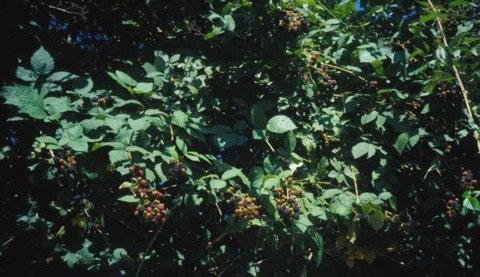
|
| Himalaya Blackberry; Rubus armeniacus Focke |
| = Rubus discolor Weihe & Nees |
| = Rubus procerus P.J. Muell. |
Rose Family; ROSACEÆ
|
| Himalaya Blackberry is one of Seattle's best known plants. To most of us it is
the common blackberry. No wild fruit is as familiar west of the Cascades, and people who don't even consider harvesting other wild edibles often partake joyfully of this. The plant
is characterized not only by its luscious black berries in August, but by astonishing vigor, and thumbtack-like thorns. It can be a Major Weed. Here is its story. |
| Before Europeans made themselves at home west of the Cascades, the native Americans ate berries from native
brambles: Salmonberries (Rubus spectabilis), Thimbleberries (R. parviflorus), Trailing Blackberries (R. ursinus) and Blackcap Raspberries (R. leucodermis) were all harvested. If you want to learn more about these native fruits, consult ethnobotanical writings by Nancy J.
Turner et al. |
| Luther Burbank, greatest ever of plant-breeders, introduced the Himalaya Blackberry in 1885. During his long career he
originated such new creations as Shasta Daisies, Elephant Garlic, Burbank Potato, Thundercloud Plum, Spineless Cactus, Pineapple Quince,
Santa Rosa Plum and hundreds more. Reading about this one person's achievements amazes and inspires us. Obtaining the Himalaya berry
was one of his comparatively easy endeavors. Burbank simply exchanged seeds with a source in India. He named the best of his seedlings
so raised 'Himalaya Giant' to commemorate its origin. We don't know how many seedlings he had. But the one he named and released
has made itself thoroughly wild on the West Coast in northern California well into British Columbia. Birds spread the berries. The
root-systems are tough and extensive. Native vegetation is choked-out by the invasive bramble. |
| The plant can be found in any soil, as well as in most degrees of shade or light. Cattail marshes, old-growth forests, clearcuts,
alley edges, neglected back yards, freeway margins,
etc., all host thriving patches. It is semievergreen, with canes that can shoot out over 30
feet in one growing season. Some reports say 40 feet and I will not deny the possibility. They can take root at the ends if touching soil. In
spring the canes are ever so juicy (edible peeled, but bland flavored) and snap easily. They branch and elongate all summer, gradually
hardening. The following year they flower in late May and June. |
| The blossoms are something like those of apple trees: palest pink in the bud stage, opening white, attractive to behold and
beloved by bees. The first berries ripen enough for eating in July. They go from hard green knobs to red, then purplish-black, finally pure
black, soft and delectable. The main crop is in August. Late August or September rains can cause some rotting. Good berries can still be had
into October. About pies, jams and other such treats, this is not the place to advise you. |
| The leaves are compound, like a hand with five broad fingers, and are dull, fuzzy whitish on the undersides, minutely prickly;
not anything markedly ornamental. They drop reluctantly in late fall or winter, with minor or no pretty coloration. Many stay on green all
year. A cane normally dies after it bears fruit, but some live several years, especially if they are cut back repeatedly by people. They turn
purplish in winter. The dead canes are brown and hard, then slowly turn bleached gray color. Scratches from the thorns are a bloody pain which
causes people to swear viciously or cry. |
| But most of you already know all this. You may prefer to be informed how to control or eliminate the thing. Pray for ruthless
single-mined focus. Arm yourself with tough leather gloves and weapons of choice. Go to it, hacking and uprooting like a demon. Even if
you have already poisoned the canes, the job of removing them is still every bit as prickly, sometimes more so. But you must clear the
land. Then, lick your wounds and watch the new sprouts appear. Kill them instantly. Repeat as necessary. It took me years to beat a small
patch, so if you have a large infestation, do not feel like a wimp if you cannot defeat it in one attempt. |
| Often people give up. For not only is the battle difficult, but there are the berries. Their richly flavored, warm juice on your
tongue on a hot August day, cannot help but make you think twice. "Control" rather than total elimination becomes an engaging dream. It
can be done, and is not necessarily a major job. The amount of work required is directly related to the number of brambles, so a small clump
of course is easily managed by anyone willing to putter around the yard and pay attention to the plant's growth habits. |
My advice: eat wild Himalaya berries, but in your own garden grow something
tame. Thornless blackberries exist. There are all sorts of Rubus with edible berries, such as: Boysenberry, Cloudberry, Loganberry, Marionberry, Raspberry, Tayberry, Wineberry,
Youngberry. Not to mention the kinds that also grow wild here. The Evergreen or Cutleaf Blackberry (R. laciniatus) is not native, but grows wild locally. It has smaller berries of different flavor. Some people prefer them. The plant is nowhere near as strong or "aggressive" as Himalaya Blackberry.
|
Originally published as the Seattle Tilth newsletter Weed of the Month in November 1990, along with an illustration drawn by
Annie Figliola or from a book(?).
Back |
|
|

